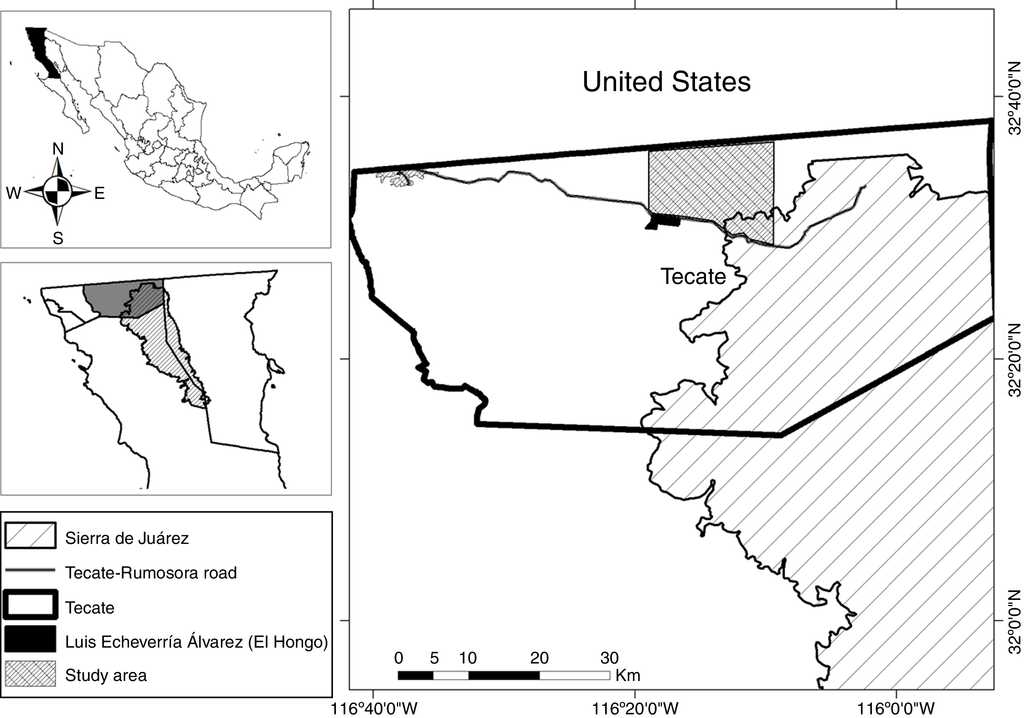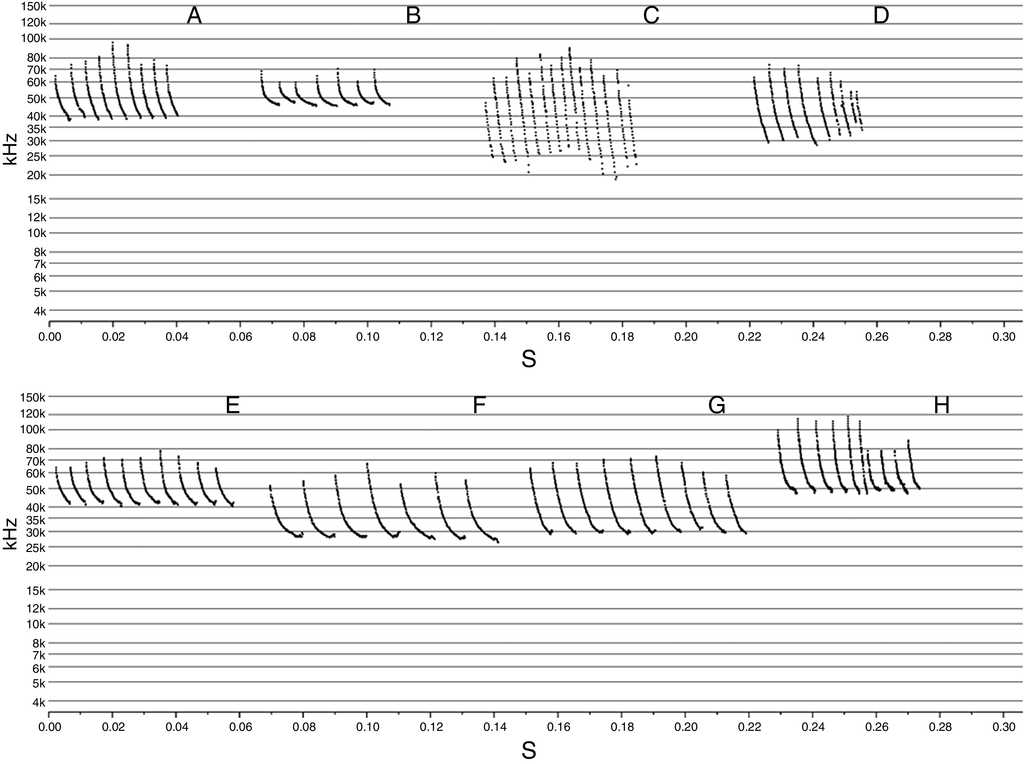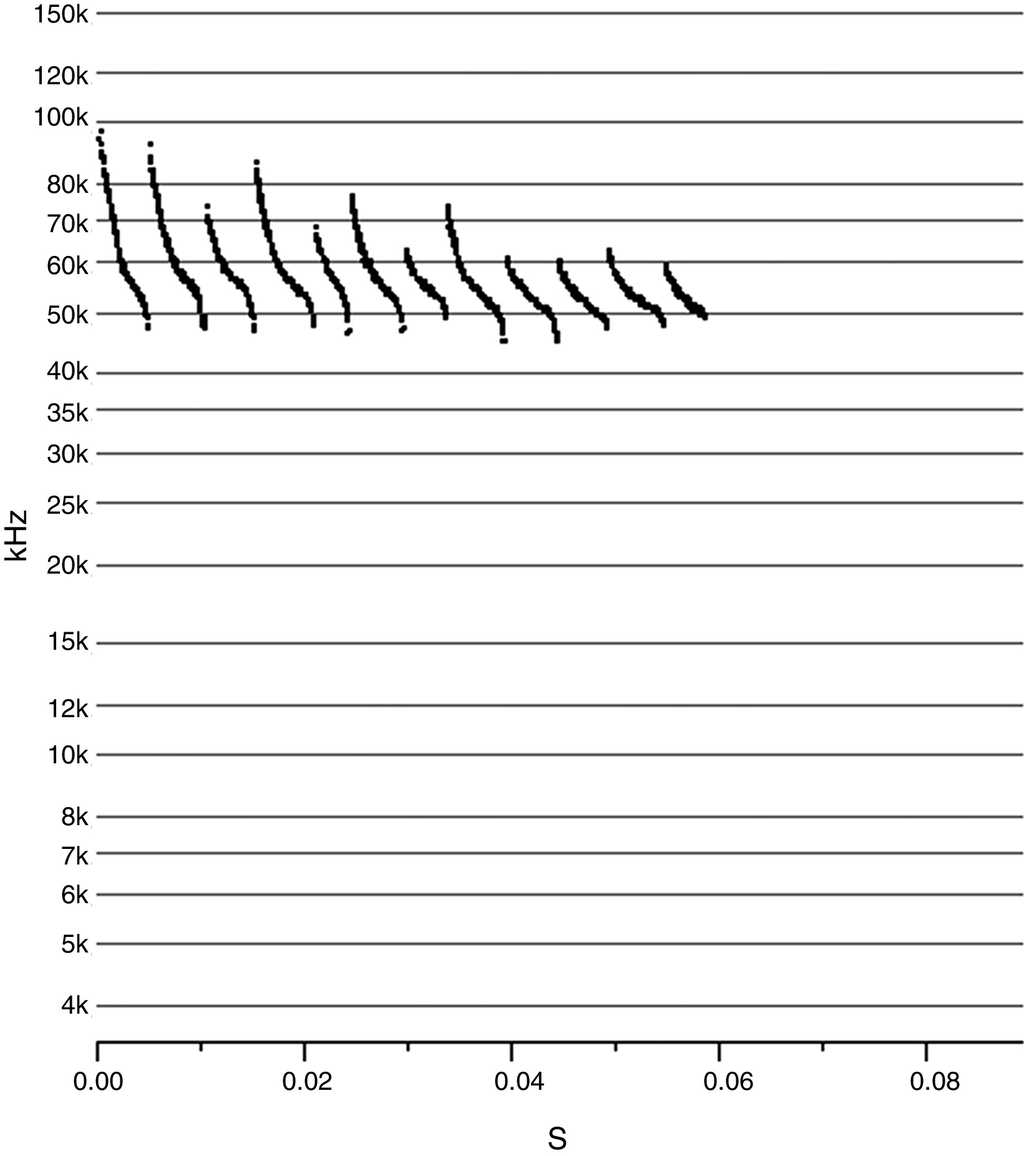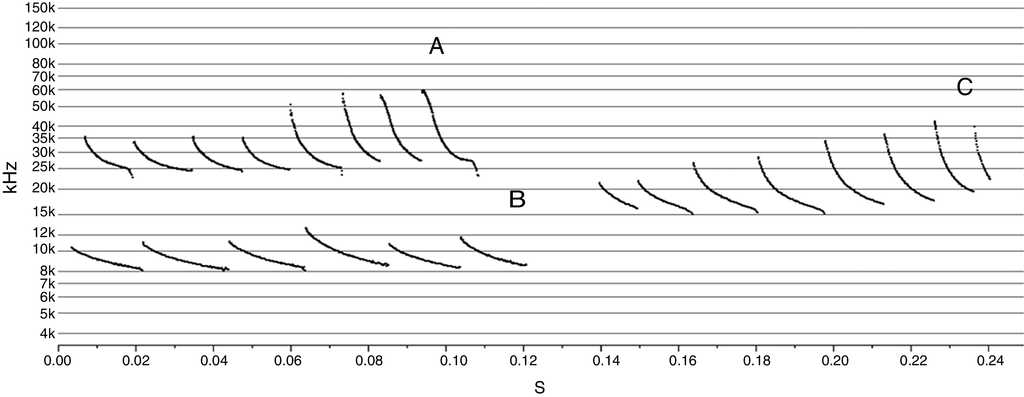Introduction
In Mexico, we can find 140 bat species, 20 of which are distributed in the state of Baja California, mainly in arid and semi-arid areas and represent the second most diverse order within the state (Martínez-Gallardo, 2011; Ramírez-Pulido, González-Ruiz, Gardner, & Arroyo-Cabrales, 2014). The Baja California Peninsula is an unique environmental region as a result of its geological history; it belongs to the biogeographical province of California (Álvarez-Castañeda, Ríos, Cortés-Calva, González-Ruiz, & Suárez-Gracida, 2008). In this region, several species of bats have adapted, and therefore each of them results particularly interesting in contrast with those of other areas of the country.
At a local level, limited information is available for this group, mainly in the northern part of the state (Guevara-Carrizales, Zamora-Gutiérrez, Gonzáles-Gómez, & Martínez-Gallardo, 2013). Estimating species richness recorded in an area at a given time region is essential for the biological conservation of biodiversity (Boulinier, Nichols, Sauer, Hines, & Pollock, 1998), and is also relevant when dealing with the design of strategies, use and protection of Mexican biological resources especially in regions with limited information (Martínez-Gallardo, 2007). In the northern part of Baja California several of the bat species that have been registered are insectivorous species of the Emballonuridae, Molossidae and some Vespertilionidae families that are difficult to register through conventional trapping methods such as mist nets, harp traps, entomological nets or birdshot shotguns, since they fly at high altitudes. As a consequence, only certain groups may be registered and biological inventories remain far from being complete (Briones-Salas, Peralta-Pérez, & García-Luis, 2013; Rydell, Arita, Santos, & Granados, 2002).
Because most of the bat species emit high-frequency ultrasonic sounds when foraging, these ultrasonic waves has been used for diagnostic purposes in many species, since each of them are subject to interspecific variations enabling their identification (O’Farrell & Gannon, 1999; O’Farrell & Miller, 1999; O’Farrell, Miller, & Gannon, 1999; Neuweiler, 2000; Rydell et al., 2002). With this technique and mist nets, bat species have been registered in a few zones of the northern region of Baja California, within the protected areas “Parque Nacional Constitución de 1857, Parque Nacional Sierra de San Pedro Mártir” where 15 and 14 species respectively (Martínez-Gallardo, 2007) have been recorded, whereas in “Reserva de la Biosfera Alto Golfo de California y Delta del Río Colorado” 7 species were detected (Guevara-Carrizales et al., 2013). The scarce information on bat richness also emphasizes the need for supplementing the bat sound libraries of the region.
The use of a combination of mist nets and ultrasonic detectors represents a good strategy to calculate the number of bat species in a specific locality, since the ultrasonic detectors record those species that fly at low and high altitudes (Briones-Salas et al., 2013). In addition, the use of ultrasonic detectors improves the information of the species sound libraries and records their variations in different geographical locations (Barclay & Brigham, 2004; Guevara-Carrizales et al., 2013; Neuweiler, 2000; Rydell et al., 2002). The combination of both methods increases the chances of detecting bats in a given area. Therefore, the objective of this research was to study the richness of existing insectivorous bats using these methods in the Ejido Jacumé, municipality of Tecate in the State of Baja California, Mexico.
Materials and methods
The study was conducted in the Ejido Jacumé, located 10.8 km NE of village Luis Echeverría Álvarez “El Hongo”, in the municipality of Tecate, in the state of Baja California, with geographical coordinates at 32°33′0.6″ N, 116°15′20″ W (Fig. 1). The area belongs to the biogeographical region known as Province of California (Arriaga, Aguilar, Espinosa-Organista, & Jiménez, 1997; Espinosa & Ocegueda, 2008; Morrone, 2005; Rzedowski, 2006) and part of this area is within the Priority Terrestrial Region “Sierra of Juarez” (RTP-12) considered as an important environmental area by the Mexican governmental institution Comisión Nacional para el Conocimiento y Uso de la Biodiversidad (Arriaga-Cabrera et al., 2000).

Figure 1 Study area in the Ejido Jacumé, northeast of Luis Echeverría Juárez, “El Hongo” in the municipality of Tecate, Baja California, Mexico.
Geologically, the terrain presents a landscape formed by plateaus and plains resulting in depressions that form bogs that are delimited by extended rolling hills and numerous steep rock formations (Johnson, 2003). The average of annual temperature is 18-22 °C with rainfall between summer and winter. The predominate vegetation is composed of chaparral plant communities with small areas of microphyll desert shrubs and a few individuals of Pinus and Quercus (Arriaga-Cabrera et al., 2000; Rzedowski, 2006). Since it is a cattle production area, artificial bodies of water may be found.
Field work and data analysis
Due to the complexity of performing field work at night in the region, principally because of the activities related to the border with United States of America such as a continuing influx of migrants and difficult access by road, the collection of the specimens was done during months suggested by local authorities in September, October and November 2013, as well as in May and June 2014. Six mist nets (6 × 2.5 m and 12 × 2.5 m) were used and placed in areas where an increased activity of bats was observed resulting in different sample effort in these areas, such as in water bodies, swamps, small natural creeks, cattle drinking troughs, wells and dams distributed in the 3 different types of vegetation identified in the polygon (Fig. 1). This sampling method has advantages and disadvantages, but is relevant for many ecological studies such as the detection of rare species (Hedgren & Weslien, 2007). Mist nets were placed in 10 different sites during 176 hours for 26 days using a total of 2,670 m of nets with an average sampling effort of 102.7 m of nets per night, every night comprised 1.5 hour before the end of evening astronomical twilight. Each of the captured specimens were handled in accordance with the American Society of Mammalogists guidelines (Sikes, Gannon, & The Animal Care and Use of the American Society of Mammalogists, 2011) and were identified using specialized field keys (Álvarez, Álvarez-Castañeda, & López-Vidal, 1994; Medellín, Arita, & Sánchez, 2008). Data such as age, sex and reproductive status was registered before release on the same night, as well as the site where each one was captured. Additionally, some reference specimens were conventionally prepared to be deposited and cataloged in the Colección Nacional de Mamíferos, Instituto de Biología, Universidad Nacional Autónoma de México, under the scientific collector permit FAUT-0070.
The Anabat bat detector SD2 (Titley Electronics, Ballina, New South Wales, Australia) was used for the ultrasonic detection of the bats. The device was placed on the same site 2 m away from where the mist nets were installed, these were set during 7 hours, every night 1.5 hour before the astronomical twilight approximately at 0.3 m height when there were moderate or strong winds, and at 1.5 m when there were no airflows. The position of the bat detector in both cases was at an angle of 45° (O’Farrell & Gannon, 1999; Weller & Zabel, 2002). Data was recorded on a memory card and the files were later transferred to a computer where all the spectrograms of the recordings were displayed and analyzed with the Analook© software version 4.1d (Titley ElectronicsTM). The identification of the species from the spectrogram visual representations was conducted through the analysis of the pulse structure, determined by its frequency in kilohertz (kHz); the duration of the call measured in milliseconds (ms), and the parameters established by the software such as the minimum frequency, the maximum frequency and the duration of the calls (O’Farrell et al., 1999; Simmons, Fenton, & O’Farrell, 1979). Subsequently, these qualitative and quantitative features were compared with previous studies (Briones-Salas et al., 2013; Corben, 2002; Guevara-Carrizales et al., 2013; Kalko, 1995; O’Farrell, 1997; Orozco-Lugo, Guillén-Servent, Valenzuela-Galván, & Arita, 2013; Pierson & Rainey, 1998; Rydell et al., 2002) using the BATCALL online sound library (http://www.msb.unm.edu/mammals/batcall/html/speciesaccounts.html) for the species identification.
Results
We found 12 bat species within the area, these represent 67% of the total registered species in the arid and semi-arid areas of Baja California and 60% for the entire state. With the use of mist nets, 27 individuals of the Vespertilionidae family belonging to five genera and 5 species were captured. Corynorhinus townsendii: 14 adult females were captured between 57 min before and 153 min after the astronomical twilight. Myotis melanorhinus: 3 females and 3 adult males were captured between 85 min before and 137 min after the astronomical twilight. Antrozous pallidus: 3 adult females and 1 subadult male were captured between 84 and 29 min before the astronomical twilight. Parastrellus hesperus: 2 adult females were captured between 25 and 29 min before the astronomical twilight. Eptesicus fuscus: only a subadult male was captured 84 min before the astronomical twilight. None of the 27 specimens were reproductively active at the time of its capture. Five of these individuals were prepared and deposited in the Colección Nacional de Mamíferos (CNMA): 2 specimens of Corynorhinus townsendi (CNMA 46971 and CNMA 46972) and individuals of Eptesicus fuscus (CNMA 46973), Myotis melanorhinus (CNMA 46974) and Parastrellus hesperus (CNMA 46975).
Ultrasonic bat records were carried out during 23 days with a total of 155 recording hours resulting in 4,969 files. Only 62% of these files could be used for analysis because the quality of the recordings. Twelve species of the Vespertilionidae, Molossidae and Phyllostomidae families were identified (Table 1); 7 were not registered when using the mist nets.
Table 1 Average quantitative characteristics and standard deviation (±SD) of the ultrasonic echolocation sounds of bat species registered in the Ejido Jacumé in Tecate, Baja California.
| Family | Species | N | Maximum frequency (kHz) | Minimum frequency (kHz) | Duration (ms) |
|---|---|---|---|---|---|
| Vespertilionidae | Corynorhinus townsendii | 629 | 56.7 ± 13.37 | 26.57 ± 2.98 | 2.67 ± 0.58 |
| Eptesicus fuscus | 31 | 53.44 ± 5.82 | 32.79 ± 0.86 | 7.20 ± 1.27 | |
| Lasiurus blossevillii | 23 | 64.63 ± 3.68 | 44.26 ± 2.28 | 5.42 ± 0.38 | |
| Lasiurus xanthinus | 8 | 42.42 ± 6.49 | 28.86 ± 1.73 | 9.20 ± 0.57 | |
| Myotis californicus | 2 | 75.94 ± 8.78 | 51.87 ± 1.68 | 3.25 ± 1.06 | |
| Myotis melanorhinus | 963 | 64.90 ± 9.36 | 41.70 ± 1.27 | 2.70 ± 0.59 | |
| Parastrellus hesperus | 811 | 55.09 ± 4.11 | 44.90 ± 1.35 | 5.35 ± 0.93 | |
| Antrozous pallidus | 299 | 57.99 ± 6.42 | 35.04 ± 2.97 | 4.13 ± 1.28 | |
| Molossidae | Nyctinomops femorosaccus | 144 | 18.69 ± 2.76 | 15.56 ± 1.98 | 13.66 ± 2.65 |
| Tadarida brasiliensis | 169 | 34.17 ± 5.88 | 24.34 ± 3.05 | 12.60 ± 1.99 | |
| Eumops perotis | 6 | 14.36 ± 2.38 | 9.62 ± 1.04 | 17.06 ± 2.90 | |
| Phyllostomidae | Macrotus californicus | 1 | 65.69 | 51.27 | 4.50 |
| Total = 3,086 |
For the family Vespertilionidae, 2,766 records belonging to 8 species were obtained. The species with the highest number of registrations was M. melanorhinus (Fig. 2A) followed by P. hesperus (Fig. 2B) that was mainly identified by the very distinctive shape of their call that regularly exhibits very steep slopes. Two species with highest number of records were C. townsendii (Fig. 2C) and A. pallidus (Fig. 2D), the identification of these species was obtained mainly by using the vertical shape of the calls. On the other hand, among the species with only a few records of detected calls were Lasiurus blossevillii (Fig. 2E), Lasiurus xanthinus (Fig. 2F), E. fuscus (Fig. 2G) and M. californicus (Fig. 2H).

Figure 2 Sonogram visualizing echolocation pulses of 7 species of insectivorous bats of the Verpertilionidae family registered in Ejido Jacumé, Baja California, Mexico. (A) Myotis melanorhinus, (B) Parastrellus hesperus, (C) Corynorhinus townsendii, (D) Antrozous pallidus, (E) Lasiurus blossevilli, (F) Lasiurus xanthinus, (G) Eptesicus fuscus, and (H) Myotis californicus. kHz: kilohertz, s: seconds.
The family Phyllostomidae was represented by only 1 record of Macrotus californicus (Fig. 3). The identification was done using the diagonal shape that characterizes their call, in addition to its associated parameters. For the family Mollosidae, 319 records belonging to 3 different species were obtained. The calls of Tadarida brasiliensis (Fig. 4A) and Nyctinomops femorosaccus (Fig. 4C) were the most recorded, unlike the Eumops perotis (Fig. 4B). The identification of these species was based on the shape of the call and the minimum average frequency recorded. The 3 species presented slightly concave, flat shape calls and were more curved in T. brasiliensis and N. femorosaccus (Fig. 4).

Figure 3 Sonogram visualizing echolocation pulses of Macrotus californicus (Molossidae family) registered in the Ejido Jacumé, Baja California, Mexico. kHz: kilohertz, s: seconds.
Discussion
Bats has been studied mostly using conventional sampling methods (mist nets, entomological nets, pellets shotgun and harp traps) which implies capture and most of the time causes death to some specimens which at the same time causes stress to other individuals or to the communities under research (Mora et al., 2002). Additionally, by using these methods not all bat species are equally susceptible to being captured, such as some groups that fly at high altitudes (family Mollosidae) which make capture difficult using conventional methods (Briones-Salas et al., 2013).
In addition to the conventional methods, bat acoustic monitoring can provide in some cases additional and effective information on the presence and species richness within a specific area. However, this method still requires the development of protocols for the standardization of information because there are still some weaknesses such as considering the analysis tools (software) and the digital processing of ultrasonic calls since a good use of this information allows for the performance of a reliable depuration of call pulses and spectrograms (Cortés-Calva, 2013). An inherent disadvantage for detection of bat species that hunt flying insects in relatively open areas, such as some species registered in this study, is that they emit call pulses whose general characteristics could be similar or overlap with those of other species, especially those which are considered as phylogenetically close or those with similar size and foraging behavior (Ahlén & Baagøe, 2000; Fenton & Bogdanowicz, 2002).
In this study combining the use of the mist nets with the acoustic detector showed good results, even though with the mist nets we detected a smaller number of species, those records were of great value for collecting biological specimens and identifying different species with similar calls, mainly those of the Vespertillionidae family. The calls of M. melanorhinus and M. californicus species (Fig. 2A, H) were similar although, in this case they could be identified separately in only 2 recordings of the latter considering the higher minimum average frequency (51.87 kHz), unlike the first one that is lower (41.7 kHz). Although the parameters associated with the echolocation calls of this species may be similar to those recorded by M. melanorhinus and M. californicus, the terminal shape of the call shows a very distinctive shallow slope that differentiates this from the prior species.
Other species with similar calls were L. blossevillii, L. xanthinus and E. fuscus. The first 2 species were mainly identified by their minimum average frequency which for L. blossevillii was 44.26 kHz (Fig. 2E) and for L. xanthinus 28.86 kHz (Fig. 2F). Similarly, the calls of E. fuscus (Fig. 2G) were identified by their distinctive characteristics in the shape of the calls and although they may be similar to those of L. xanthinus, the minimum average frequency of E. fuscus was of 32.79 kHz. The species C. townsendii and A. pallidus (Fig. 2C, D) were identified by the average duration of the call, showing that it is shorter in the first species than in A. pallidus and the minimum average frequency has a lower value in C. townsendii (26.57 kHz) than in A. pallidus (35.04 kHz).
The combination of conventional capture techniques sampling using mist nets and ultrasonic detectors was fundamental for obtaining the data, since the percentage achieved is similar to samplings in natural protected areas of the state with different environments (Álvarez-Castañeda et al., 2008; Flores-Rojas, 2006; Guevara-Carrizales et al., 2013). Some of the species recorded, such as E. perotis, L. xanthinus, L. blossevillii and M. melanorhinus are under-represented in the arid and semi-arid areas within the region with a considerable number of records for some of them, but very poorly represented in biological collections, some which do not exceed a dozen specimens (Martínez-Gallardo, 2011). The species with more individuals captured using mist nets in the area were M. melanorhinus, P. hesperus, C. townsendii, and A. pallidus, that were recorded after being captured with mist nets; these species were also the most common in the ultrasonic recordings along with T. brasiliensis and N. femorosaccus. On the other hand, the species with the lowest number of ultrasonic records were Macrotus californicus, E. perotis, L. xanthinus, E. fuscus, and Myotis californicus. The species registered by both methods were found in great numbers near large water bodies such as dams and swamps, in these areas individuals were captured in mists nets from around 1.5 hour before and 2.5 hours after the astronomical twilight as has been reported in other studies in northwest of the country (Tuttle & Moreno, 2005).
Few records are available on the chiropteran wildlife in the northern area of the state of Baja California, although various studies have been carried out for the arid and semi-arid regions, that include direct capture registration, ultrasonic detectors and search of specimens deposited in collections in Mexico and the United States, at national parks and in Priority Terrestrial Regions (Guevara-Carrizales et al., 2013; Martínez-Gallardo, 2007, 2011). Preliminary information suggests that some species have few records in the state of Baja California such as E. perotis, E. fuscus, L. blossevilli and L. xanthinus. Thus, this study gathers new information on these species in the Ejido Jacumm area, municipality of Tecate and provides new ultrasonic records of their calls. Despite this, some of the insectivorous species recorded for the arid and semi-arid areas, such as Myotis yumanensis, M. thysanodes, M. volans and M. vivesi and frugivorous and nectarivorous species such as Choeronycteris mexicana and Leptonycteris yerbabuenae, were not found because the methodology was not designed for this purpose. In addition, we found no evidence of the presence of M. evotis, a species that remains under special protection in the NOM-059-SEMARNAT-2010 (Semarnat, 2010) and whose distribution has also been reported in Baja California (Buseck & Keinath, 2004).
It is important to mention that due to the difficulties surrounding the study area, the sampling design did not include several months of the year and therefore the sampling effort set for this study may be insufficient to detect some species registered previously, for example it has been recorded for other regions of the country that the activity of some bats is different in some months of the year due to different environmental and social factors (Santos-Moreno, Ruiz, & Sánchez, 2010). Regardless of this situation, the results in this study contribute significantly to the information on bat richness in the area and demonstrate the need of continuing this type of basic studies in order to increase the diversity knowledge as well as, to provide the real number of bat species that inhabit this small area within the municipality of Tecate.
In addition to the remarkable diversity of bats in the Ejido Jacumé area, the reduction of the habitat in this region is notorious, as a result of increased human activities in recent years, such as poorly planned tourism activities, extensive livestock farming and development of energy projects such as wind farms, mainly in the northern part of the state as well as, in the municipality of Tecate. These activities can cause a negative effect on the populations of bats due to the deterioration of the quality of suitable habitat; the long lasting changes in the landscape and its functions, and additionally, the extinction of refuge sites (Petrov, 2008). The records obtained in this study, specifically in the northern area of the municipality of Tecate, Baja California, provide information which characterize the richness of bats. The presence of these captured species contributes to the improvement of knowledge of sound recordings on the insectivorous bats of the state of Baja California. Particularly, this information represents an important effort to increase the knowledge of species presence for this group of mammals in this area.











 nova página do texto(beta)
nova página do texto(beta)



